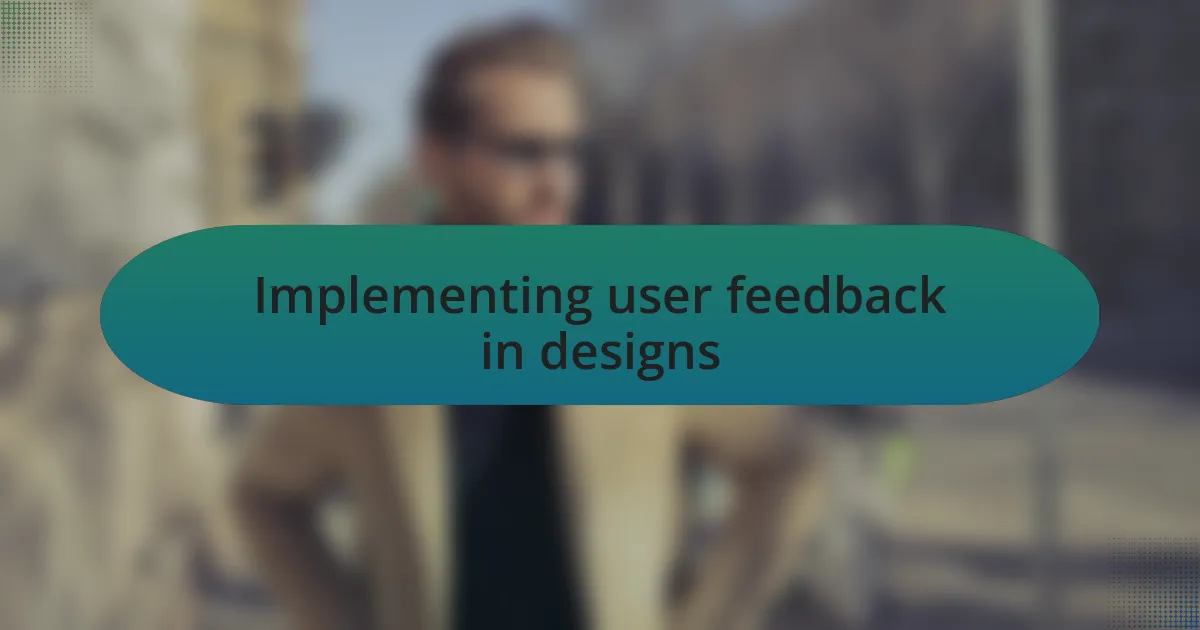Key takeaways:
- User feedback is essential for shaping fashion content, guiding design choices, and fostering community engagement.
- Effective collection methods include surveys, social media polls, and comment sections, which enhance real-time dialogue with the audience.
- Implementing feedback leads to tangible improvements, such as enhanced accessibility and diversity in content.
- Future improvements will focus on blog format, community interaction opportunities, and the frequency of content updates to better meet audience needs.

Understanding user feedback in fashion
User feedback in fashion is crucial because it reveals genuine sentiments about designs and trends. I remember when I launched a new collection, and I eagerly awaited the responses. Hearing my audience’s excitement or criticisms shaped my approach significantly, showing me that their voices carry the pulse of the fashion community.
By actively listening to user feedback, I’ve learned to refine my aesthetic and cater to what resonates with my readers. For instance, a comment highlighting the need for eco-friendly materials inspired me to explore sustainable options in my designs. It made me realize how their needs could guide my creative journey, tailoring my work to align with my audience’s values and preferences.
It’s fascinating to think about how feedback can transform a blog. Have you ever considered how a single suggestion might spark a whole new direction? When I received tips on diversifying content formats—like incorporating more visual storytelling—my blog’s engagement soared. Those interactions taught me that user feedback is not just input; it’s a vital resource that keeps my fashion journey dynamic and user-centric.

Methods for collecting user feedback
Collecting user feedback can take various forms, and I’ve found surveys to be incredibly effective. After running a recent survey on my blog, I was amazed by the depth of insights it provided. I asked readers about their favorite styles and what they were eager to see more of, and the responses guided my next feature. Isn’t it rewarding when you realize that just a few questions can unlock a treasure trove of ideas?
Another method I’ve employed is social media polls, which allow for quick engagement and instant feedback. I remember hosting a poll asking my followers to choose between two design concepts. The level of interaction was energizing! It wasn’t just about collecting answers; it was a real-time dialogue that fostered a sense of community. Have you ever felt the buzz of excitement when your audience rallies around their preferences?
Lastly, I’ve engaged with readers through comment sections on my blog. When I notice recurring themes or suggestions, I make it a point to respond thoughtfully. One comment about exploring vintage fashion brought back memories of my own experiences searching for unique pieces. This dialogue doesn’t just inform my content; it creates a shared passion that enriches the overall experience for both me and my audience. How often do we overlook these simple interactions that can shape our creative paths?

Analyzing user feedback effectively
Analyzing user feedback effectively is crucial when refining my blog’s content. I often start by categorizing feedback into themes, like design preferences or content types. For instance, when a trend emerged around sustainable fashion, I noticed several comments requesting more articles on eco-friendly materials. This pattern showed me how much my readers value sustainability, and it really motivated me to explore that topic further.
Sometimes, I find it beneficial to create a comparative analysis of user feedback over time. I once went back to review feedback after a major redesign of my blog. What struck me was how certain aspects that excited me didn’t resonate much with my audience. This realization helped me pivot my focus back to what truly matters to my readers. Have you ever experienced that moment when you realize the need to adjust your approach based on user insights?
Another effective strategy is to visualize the feedback data. I’ve turned comments and responses into word clouds or graphs, which highlights commonly mentioned themes. It’s fascinating to see which keywords pop up frequently and how they guide my upcoming posts. When I first tried this technique, it felt like peeling back layers of insight, revealing what my audience genuinely craved. Wouldn’t it be incredible if visualizing feedback transformed the way you approach content creation?

Implementing user feedback in designs
Feedback implementation is where the magic truly happens in design. When I started actively integrating user feedback, I realized it wasn’t just about accepting suggestions; it was about creating a dialogue. For example, after a user mentioned the difficulty of navigating my blog on mobile, I immediately prioritized a responsive redesign. The relief I felt when I received positive comments post-implementation was incredibly rewarding. Isn’t it uplifting to know that listening can lead to tangible improvements?
Building upon user insights also means being willing to experiment and take risks. I recall a time when a reader suggested a fresh color palette for my blog. I decided to run a little test—creating two versions of a page and asking my audience which one they preferred. The results surprised me; I had assumed one choice would reign supreme, but the underdog won! That experience reinforced my understanding that sometimes, readers see things from a different perspective than I do. Have you ever underestimated your audience’s taste only to be pleasantly surprised?
It’s essential to create a feedback loop after implementing changes. Once I rolled out a new feature based on user suggestions, I followed up with a quick survey to gauge their reactions. The responses poured in, and to my delight, people appreciated the changes and offered additional ideas for improvement. It felt like I was not just designing for them, but with them. How often do we miss the opportunity to connect further by simply asking, “What do you think?”

Personal experiences with user feedback
User feedback has been instrumental in shaping my fashion design blog. I remember one instance when a loyal reader reached out about the complexity of some articles. Her suggestion led me to create simplified summaries at the end of my posts. Seeing that change resonate with my audience, especially when they expressed gratitude for clearer content, opened my eyes to the importance of accessibility in communication.
I’ve also encountered those moments when feedback takes an unexpected turn. A user once pointed out that my blog was lacking diversity in its featured styles and cultures. Initially, I felt defensive—after all, I had curated content based on my tastes. However, once I embraced her perspective and began highlighting a wider array of influences, I was amazed by the positive reaction from my community. It’s funny how a bit of vulnerability can turn a critique into a catalyst for growth.
Reflecting on these experiences, I realize feedback isn’t just a tool; it’s a bridge to deeper connections with my readers. Engaging with their input has allowed me to co-create content that not only resonates but thrives. It’s a powerful reminder that by opening the door to conversation, we’re not merely accepting feedback; we’re cultivating a vibrant, inclusive community. How often do we let constructive criticism lead us to greater insights than we ever anticipated?

Future improvements based on feedback
One area I’m excited to improve based on feedback is the blog’s format. After receiving suggestions from users that longer articles felt overwhelming, I started introducing concise, visually appealing infographics. These not only break down intricate design concepts but also elevate engagement by making information digestible. It’s fascinating how a simple visual can enhance a reader’s understanding and retention of complex ideas.
Another critical improvement stems from feedback about community interaction. Many followers expressed a desire for more opportunities to share their designs and thoughts. In response, I’m exploring the implementation of a dedicated section where readers can submit their creations. This could foster a sense of ownership and involvement in the blog. Why shouldn’t my audience have a space to shine?
Lastly, I’ve been considering the pacing of content updates. Some readers mentioned that they’d appreciate more frequent, shorter posts rather than occasional long ones. This is a valuable insight that has motivated me to adopt a more agile approach. I wonder how this shift in frequency will not only keep my audience engaged but also allow me to explore current trends in fashion more dynamically.